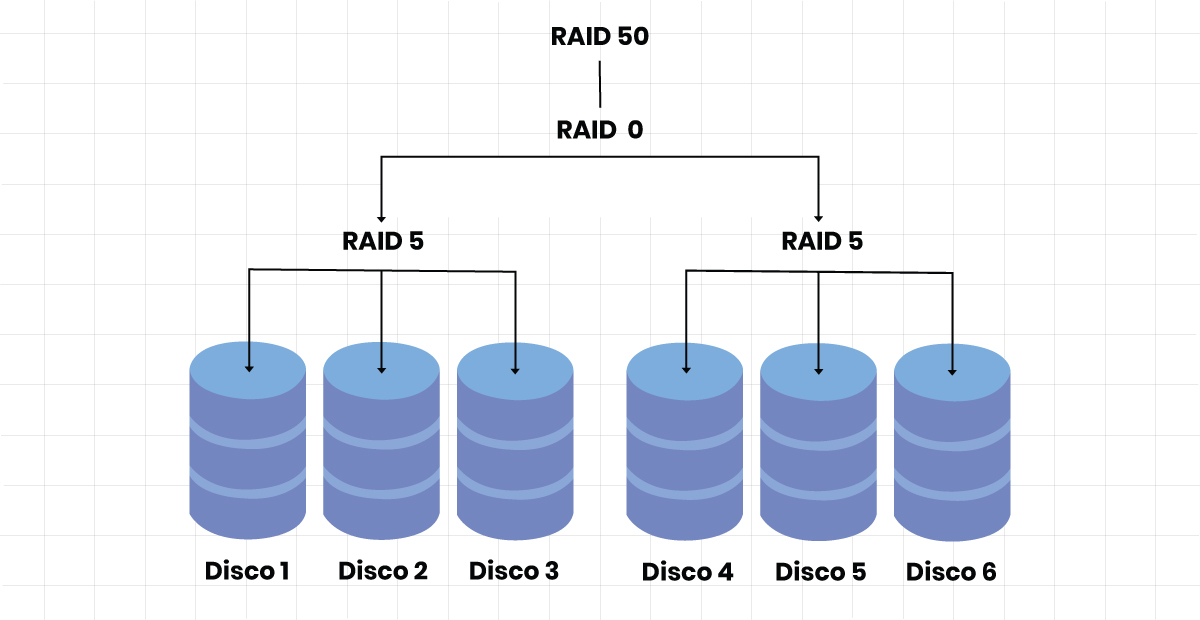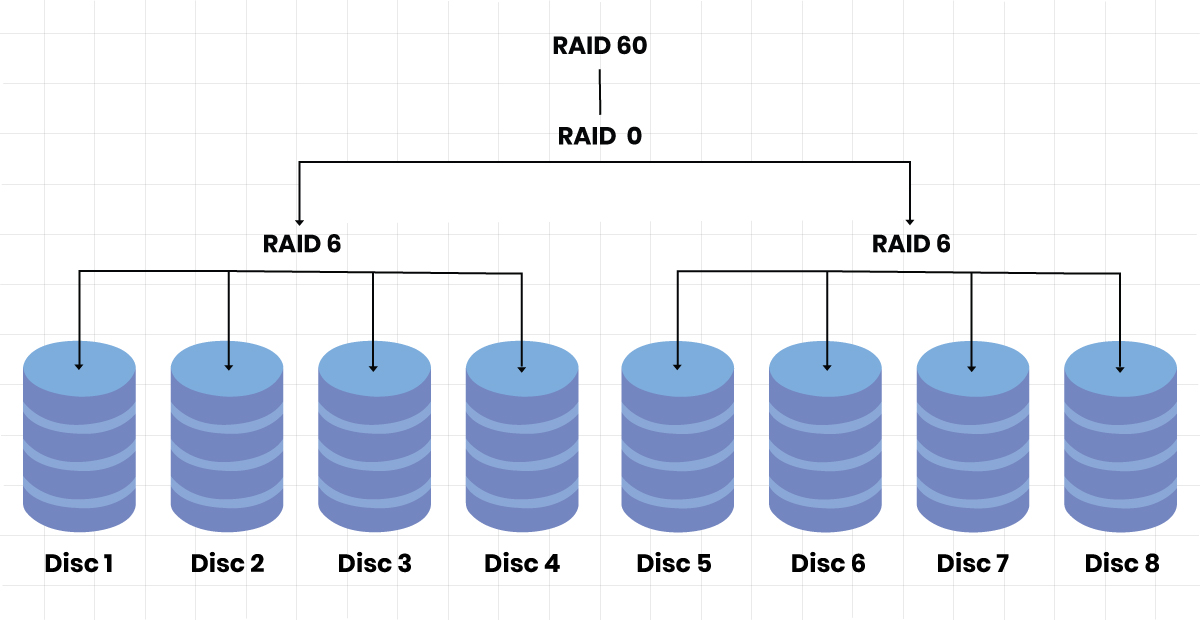Choosing the right RAID configuration is important for balancing performance, data safety, and storage space. RAID 50 and RAID 60 provide better data protection and performance than simpler RAID levels. This article compares RAID 50 and RAID 60, looking at the benefits and drawbacks of each to help you decide which one is the most suitable for your needs. We will explore how they work, their performance, and key factors to consider when choosing between the two.
What is RAID 50?

RAID 50, also known as RAID 5+0, is a nested RAID level that combines the fault tolerance of RAID 5 with the performance benefits of RAID 0. It is designed to balance data redundancy, improved write speeds, and fault tolerance, making it ideal for enterprise environments that require speed and data protection.
RAID 50 is built using striping with distributed parity—striping is the core feature of RAID 0, and distributed parity is the core feature of RAID 5. This combination enhances performance and fault tolerance, making RAID 50 a reliable choice for demanding workloads.
How RAID 50 Works?
RAID 50 combines RAID 5 (single parity) and RAID 0 (striping) to improve performance and redundancy.
First, data is written to multiple RAID 5 arrays, each of which distributes data along with a single parity block across its drives. This allows each RAID 5 array to withstand the failure of one drive while maintaining data integrity. Then, RAID 0 strips data across these RAID 5 arrays, boosting read and write speeds by distributing the workload among multiple arrays.
This setup enhances performance and storage efficiency while ensuring moderate fault tolerance.
Advantages of RAID 50
Enhanced Performance
RAID 50 offers significantly better read and write speeds than RAID 5. This improvement comes from data striping across multiple RAID 5 arrays, which allows multiple drives to handle requests simultaneously.
Reliable Redundancy
While boosting performance, RAID 50 also maintains strong fault tolerance. It distributes parity data across drives, ensuring that if one drive fails within a RAID 5 array, the data can still be recovered.
Scalability and Storage Capacity
By combining multiple RAID 5 arrays, RAID 50 supports larger storage configurations, making it a great choice for environments requiring both high capacity and speed.
What is RAID 60?

RAID 60 is built using striping with distributed double parity—striping is the core feature of RAID 0, and distributed double parity is the core feature of RAID 6. This combination enhances data protection, fault tolerance, and performance, making RAID 60 a highly reliable choice for critical applications requiring maximum redundancy and resilience against drive failures.
How RAID 60 Works?
RAID 60 enhances data redundancy and performance by combining RAID 6 (dual-parity) and RAID 0 (striping).
First, data is written to multiple RAID 6 arrays, where each array distributes data along with two parity blocks across its drives. This ensures that even if two drives fail within a single RAID 6 array, data remains recoverable. Then, RAID 0 strips data across these RAID 6 arrays, improving overall read and write speeds by allowing multiple arrays to work simultaneously.
This structure balances fault tolerance and performance, making RAID 60 highly resilient against drive failures while maintaining efficient data access.
Advantages of RAID 60
Superior Redundancy
RAID 60 offers excellent fault tolerance with dual parity blocks in each RAID 6 array. It can survive up to two drive failures per array without data loss, making it more reliable than RAID 50.
Balanced Performance
Although slightly slower than RAID 50, RAID 60 delivers solid performance, particularly for read-intensive workloads where data access speed is crucial.
Strong Data Integrity
RAID 60 ensures high data integrity by handling multiple drive failures, making it ideal for mission-critical applications.
Detailed Comparison: RAID 50 vs RAID 60
|
Feature |
RAID 50 |
RAID 60 |
|
RAID Levels Used |
Combines RAID 5 + RAID 0 (Striped RAID 5 arrays) |
Combines RAID 6 + RAID 0 (Striped RAID 6 arrays) |
|
Minimum Drives Required |
At least six (two RAID 5 arrays with three drives each) |
At least eight (two RAID 6 arrays with four drives each) |
|
Fault Tolerance |
Can tolerate one drive failure per RAID 5 array |
Can tolerate two drive failures per RAID 6 array |
|
Performance (Read/Write Speed) |
Faster write performance than RAID 60 due to single parity overhead |
Slower write speed than RAID 50 due to dual parity calculations |
|
Read Performance |
High-speed reads due to striping across multiple RAID 5 arrays |
Good read performance, but slightly slower than RAID 50 |
|
Write Performance |
Better write speed than RAID 60 as RAID 5 uses single parity |
Slower write speed due to dual parity calculations |
|
Redundancy Level |
Moderate (1 drive failure per RAID 5 array) |
High (2 drive failures per RAID 6 array) |
|
Rebuild Time |
Faster rebuild times than RAID 60 due to lower parity overhead |
Slower rebuild times as RAID 6 needs to restore dual parity |
|
Storage Efficiency |
More usable storage space as RAID 5 only uses one parity disk per array |
Less usable storage space since RAID 6 reserves two disks per array for parity |
|
Data Integrity |
Good, but limited by RAID 5’s single parity |
Excellent, as RAID 6 ensures stronger data protection |
|
Ideal Use Cases |
Suitable for high-speed applications needing performance with some redundancy (e.g., gaming servers, media storage, databases) |
Best for critical applications needing maximum reliability (e.g., enterprise databases, large-scale data centers, archival storage) |
|
Cost Considerations |
More cost-effective as it requires fewer parity disks |
More expensive due to additional parity overhead and more disks needed |
Which One Should You Choose?
- Choose RAID 50 if you prioritize performance with moderate redundancy.
- Choose RAID 60 for maximum fault tolerance and data integrity, ideal for critical systems.
RAID 50 and RAID 60 both enhance data protection and performance, but the right choice depends on your needs. RAID 50 is ideal for high-speed applications with moderate redundancy, while RAID 60 offers superior fault tolerance for critical data environments. Carefully assess performance, redundancy, and cost to select the best RAID configuration.



